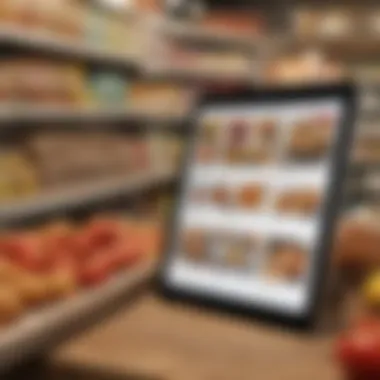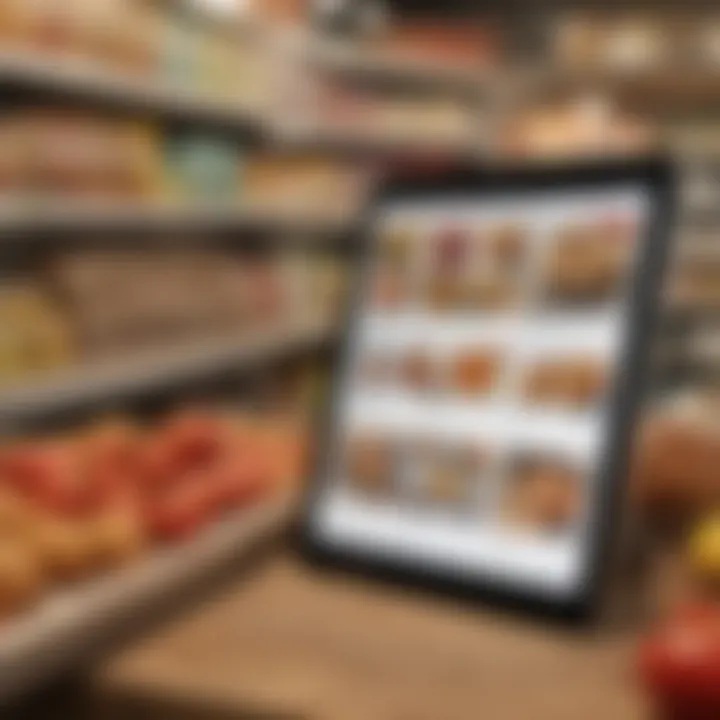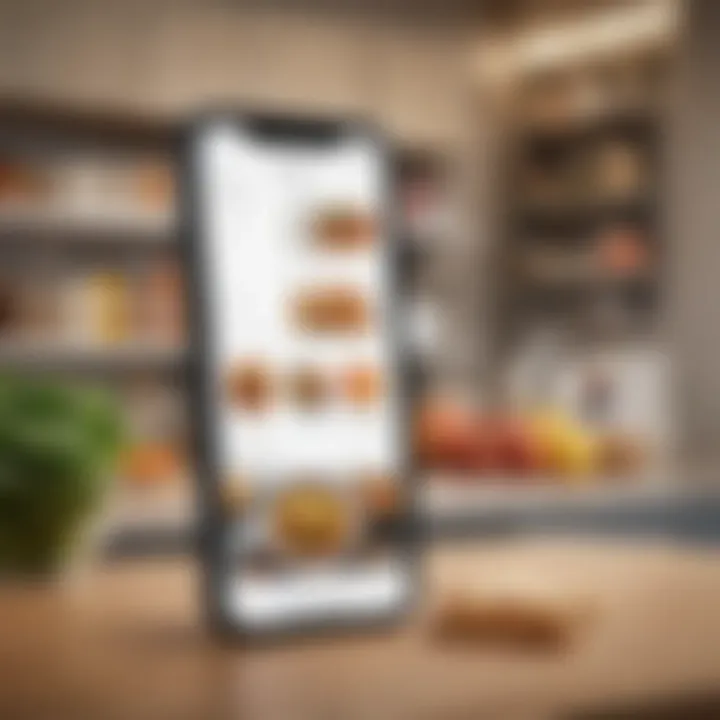Harnessing Grocery Applications for Daily Shopping Efficiency


Intro
Grocery applications are changing how people shop for food. These digital tools provide convenience and efficiency in the grocery shopping experience. This transformation impacts both daily shopping habits and broader consumer behaviors.
With more consumers relying on technology, grocery applications offer various functions. Users can browse products, build shopping lists, and even get recipes tailored to their preferences. Furthermore, these apps adapt to individual consumer limitations and needs. This guide examines various aspects of grocery apps, ranging from current functionalities to the potential future developments anticipated in app technology.
Recipe Highlight
Here we present a noteworthy recipe that aligns perfectly with the functionalities of grocery apps. It is called Quick Vegetable Stir-Fry. This dish is ideal for demonstrating the convenience of planning via grocery applications as it encourages healthy eating with minimal prep time.
The essential ingredients needed for the dish are:
- Bell peppers (mixed colors)
- Carrots
- Broccoli
- Soy sauce
- Olive oil
- Garlic
- Ginger
This recipe takes approximately 20 minutes to prepare and yields about 4 servings.
Step-by-Step Instructions
- Prep the Vegetables: Start by washing all the vegetables. Cut bell peppers into strips and slice carrots into thin rounds. Break broccoli into small florets.
- Prepare Aromatics: Mince the garlic and grate the ginger.
- Heat Oil: In a pan over medium heat, add olive oil. Wait for it to heat before continuing.
- Cook: Add garlic and ginger to the hot oil. Stir well until fragrant but not burnt (about 30 seconds).
- Add Veggies: Mix in the vegetables. Stir-fry for 5-7 minutes until they are slightly tender but still crisp.
- Season: Pour in the soy sauce. Stir again to coat the vegetables.
- Serve: Remove from heat and serve hot.
Before cooking, ensure you introduce the concept of stirring various ingredients. Stir-frying effectively maximizes flavors and nutrients while keeping the cooking time to a minimum. A common mistake to avoid is overcooking the vegetables, as they will lose both texture and nutritional value.
Variations and Substitutions
For those looking to customize this recipe, consider the following alternatives:
- Substitute soy sauce with tamari for a gluten-free option.
- Utilize seasonal vegetables such as zucchini or snap peas.
- For added protein, incorporate tofu or shrimp.
To enhance the flavor profile, vegetables can be marinated before cooking or accompanied by a sprinkle of sesame seeds. Experimenting with different herbs or spices can further diversify the meal experience. Think about sides like brown rice or quinoa to approach a well-rounded meal.
Time-Saving Cooking Tips
Efficiency starts before you even cook. Here are some practical tips:
- Prepare all vegetables ahead and keep them in the fridge. This drastically reduces the cooking time.
- Utilize a shared meal prep day to chop, prep, or sort a week’s worth of ingredients. Doing this will simplify future meals.
- Investing in a good food processor can make chopping quicker. With it, you can blend less than half the time it would normally take.
Nutritional Information
Each serving of the Quick Vegetable Stir-Fry approximately contains:
- Calories: 150 per serving
- Vegetarian Benefits: A rich source of vitamins A and C from the bell peppers and broccoli.
- Suitable for: Vegan and gluten-free diets when appropriate substitutions are made.
Grocery applications help to streamline meals such as this, encouraging users to include diverse, satisfying ingredients. The insights provided here aim to enrich the understanding of not just cooking methods but also the dietary principles that can be followed.
Grocery applications represent a key factor in shaping not only our shopping habits but also the way we prepare and enjoy meals, proving invaluable for every home chef.
Understanding Grocery Applications
Grocery applications are that part of digital technology changing founded food shopping. Grown since their inception with many feature added for enhanced user convenience, these apps now take an important role in our daily lives, influencing how we think about food. Understanding them is key to maximize their potential. The design purpose of these applications directly relates to improving everyday efficiency for grocery buyers. These apps provide time-saving tools, cost insights, recipe navigation, and reduce waste.
Definition and Purpose
Grocery applications simply refer to digital tools most often available on smart devices like phones or tablets that assist users in managing grocery shopping. They offer functions to create shopping lists, track expenses, check inventory at home, and plan meals. Their primary purpose is to simplify the grocery process, merging various tasks into one seamless experience. Users can manage campaigns to reduce spending while enjoying a more organized food preparation routine.
A well-defined grocery app does more than list items to buy. For example, functions like scanning barcodes provide easy inventory management. This and others ensure shoppers can attach precise information to each item, enhance decision making during shopping, and integrate multiple insights for informed choices.
Historical Context


The concept of grocery-related apps started evolving in the early 2000s with the advent of smartphones and digital technology. Initially basic, the examples simply permitted users to make lists on their devices instead of with pen and paper. Over the years, however, specially with changing consumer habits, they grew alongside major advancements in mobile technology. Brands like Instacart and Grocery Pal entered the market, setting a new standard – digitizing grocery shopping by connecting stores, brands, and shoppers directly.
Changing consumer habits expressed a desire for efficiency; therefore connecting grocery apps and e-commerce became a natural evolution path. By 2020, many people transitioned to online grocery shopping due to the pandemic, leading to heightened usage of grocery applications as more capabilities were developed and cooling the experience on various platforms. This historical backdrop gives value to understanding how these applications specially adapted to flow optimally in the modern world, guiding consumers through options focused on efficiency and convenience.
Core Features of Grocery Applications
The core features of grocery applications are vital for simplifying the shopping experience. With more consumers leaning towards digital solutions, understanding these features can help in selecting the right app. App functionalities directly influence convenience and efficiency when grocery shopping. Let's delve into the essential attributes of these applications.
User-Friendly Interface Design
A simple and clean user interface is crucial. Users desire applications that help them navigate easily. They do not want to spend too much time figuring out how to use the app. Intuitive icons and organized layout assist users in finding items, checking offers, or managing their shopping lists.
Users appreciate features like personalizeble home screens. These can be set according to preferences, including favorite stores or categories. Engaging users from their first interaction is wise. An appealing color scheme and clear typography enhance the overall experience. Overall, a user-friendly design significantly impacts user retention and satisfaction.
Barcode Scanning and Inventory Management
Barcode scanning is a function that many find indispensable. With it, shoppers can easily add items to their list. Using the camera to scan products speeds up listing compared to manual entry. For households using specific items frequently, quick addition can help in managing inventory more efficiently.
Self-monitoring inventory levels is also a smart feature. When users know which items need restocking, they can optimize their grocery shopping trips. Some applications may provide alerts when certain items inventory runs low. This level of function adds significant value to the everyday grocery experience.
Recipe Integration and Meal Planning
Integrating recipes within grocery applications offers significant didactic value. Users often plan their meals based on recipes they like. Being able to import recipes directly affects buying habits and encourages healthier eating.
Meal planning tools within grocery apps can allow users to compile a shopping list based on selected recipes. For many ingredient-conscious cooks, creating a plan delivers more structured cooking experiences. When app features allow users to explore ingredients in advance, they widen their culinary horizons.
Real-Time Price Comparisons
Real-time price comparisons provide valuable insight. During grocery shopping, consumers want the best deals possible. Applications that offer live pricing enable users to save money and make informed decisions. Instead of visiting multiple stores, consumers can determine where to shop in real-time. This functionality often incorporates promotions or discounts, thus maximizing savings.
Using techniques like price alerts or trends over time can empower shoppers to plan accordingly. The informed choice naturally appeals to those who value budget management and enhance overall shopping satisfaction. This leads to more faithful use of the app.
Understanding these core features can greatly improve a consumer's shopping experience and make everyday tasks more efficient.
Benefits of Using Grocery Applications
Grocery applications have emerged as significant tools for modern consumers looking to enhance their shopping routines. They not only bridge the gap between digital and physical shopping but also offer tangible benefits that elevate the overall experience. These applications cater to the diverse needs of food lovers, cooks, and housewives by improving efficiency and enhancing decision-making throughout the grocery shopping process. In this section, we will discuss various ways these applications are advantageous to users.
Time Efficiency
Time management is critical in our fast-paced world. Grocery apps significantly reduce the time spent on shopping tasks. Users can organize their lists before heading out, which allows for more streamlined trips. The ease of electronic lists minimizes forgetfulness and, consequently, the need for return trips to the store. Key features of grocery apps, such as location-based store finder tools, direct users to the nearest supermarkets with the desired products.
For individuals balancing work and family, this time-saving aspect cannot be overstated. Furthermore, many apps offer re-ordering capabilities for frequently purchased items, which simplify the process even further.
“It’s not just about saving time, it’s about making the shopping experience far smoother and more enjoyable.”
Cost-Effectiveness
Grocery applications generally provide tools to help consumers track spending and manage budgets. This element is increasingly important as food prices fluctuate. Many applications integrate direct links to current deals and promotions, which help users to find discounts applicable to their chosen products. By aggregating price comparisons throughout various stores, grocery apps enable users to make informed decisions, often resulting in savings on total bills.
Moreover, some applications come equipped with budgeting tools that allow users to set strict limits or targets for spending. These alerts help prevent overspending, ensuring users stay aligned with their financial goals.
Enhanced Shopping Experience
A well-designed grocery app contributes significantly to user satisfaction. Personalized recommendations make shopping more engaging by catering to developed tastes. Features integrated within the apps provide meal suggestions or highlight brand-new products based on prior purchases.
Advances in interface design enhance usability, making it easy for shoppers to navigate applications. The integration of community forums or shared content can also enrich the user experience through social interactions over cooking ideas and favorite products, strengthening connections between users. Overall, a tailored experience makes food shopping feel less mundane and more akin to exploring enjoyable culinary ideas.
Sustainability and Reduced Waste


In current times, sustainability has become an increasingly popular objective among consumers. grocery applications often promote healthier and sustainable buying habits. Some features assist users in tracking freshness and recommending recipes based on ingredients before they spoil. This pushes consumers toward more mindful shopping practices, which can significantly reduce food waste.
Additionally, grocery apps may facilitate local purchasing options, allowing users to directly engage with nearby producers while fostering community economics. This aspect appeals to environmentally aware consumers, achieving efficiency alongside environmental responsibility.
In summary, grocery applications deliver considerable benefits such as time efficiency, cost-effectiveness, enhanced shopping experiences, and support for sustainable practices. By embracing these tools, users contribute both to their individual livelihoods and to broader economic or ecological goals. That twist on benefits epitomizes the future of personalized grocery shopping.
User Engagement and Community Building
User engagement and community building are pivotal elements in maximizing the value of grocery applications. These factors not only enhance the user experience but also foster a sense of belonging amongst users. Positive interaction within the app encourages frequent utilization and drives loyalty, essential for retaining a diverse consumer base in a competitive market.
By focusing on user engagement, developers can create platforms that facilitate collaboration between users, making grocery shopping not just an individual task but a shared experience. Encouraging interaction promotes knowledge sharing; users gain tips, tricks, and advice from their fellow shoppers. Integrating social features like recipe sharing and discussion forums values community input, enhancing educational experiences related to cooking and meal preparation.
Moreover, heightened engagement can directly influence user satisfaction. Satisfied users are more likely to recommend an application to their peers, creating organic growth through word-of-mouth. They also invest more significantly in community-driven content and trust those peers more than traditional advertising. Therefore, investing in these connections amplifies the reliability and survival of the app.
Social Features and Recipe Sharing
Incorporating social features within grocery applications enriches their overall functionality. Applications can allow users to share their favorite recipes, providing not just inspiration but facilitating social interaction. When users post recipes, they share their culinary creativity and experiences. This unspoken bond over shared interests can generate discussions, recommendations, and constructive feedback among users.
Additionally, through social features, apps can induce a sense of accountability. Users can track their cooking adventures, showcasing modifications to recipes or authentic creations aligned with personal tastes. This interaction supports beginners in navigating the complexities of cooking without feeling overwhelmed.
These features can come with customizable settings to control sharing options, thus maintaining user comfort. Consumers can connect with those whom they trust or search for new friends, expanding both their recipe repertoire and community base. Overall, an interactive platform transforms the app from a transactional tool into a vibrant culinary network.
Personalization and User Profiles
The ability to customize user profiles significantly enhances engagement. Personalization aligns closely with shopping habits, preferences, and dietary requirements, amplifying the overall grocery shopping experience. Users inclined to see their favorite items, previous shopping lists, or tailored meal suggestions their experience becomes intuitive and user-centric.
Features such as saved parameters for allergies, preferred cuisines, and previous grocery habits help refine suggestions, improving efficiency. Personal shopping preferences influence inventory systems, ultimately guiding consumers to products they most enjoy. Residents with non-traditional diets or preferences clamour for like-minded recommendations and are more likely to interact, all of which can boost loyalty metrics.
This information can be instrumental in tailoring marketing efforts as well. Brands can reach users with custom notifications about relevant products or promotions based on their history and preferences. Thus, the user experience becomes less about guessing and more about appreciation and validation of individual choices.
Digital Marketing Strategies in Grocery Apps
In the rapidly evolving landscape of grocery shopping, the integration of digital marketing strategies is crucial for the success of grocery applications. These strategies not only increase user engagement but also enhance overall efficiency in customer acquisition and retention. As the competition intensifies, effective marketing practices allow grocery apps to distinguish themselves while creating more value for users. Such strategies lend enable brands to find their target audience and build lasting relationships with them.
Promotions and Loyalty Programs
Promotions and loyalty programs are instrumental in driving customer loyalty and boosting user interaction within grocery applications. By offering special discounts, exclusive deals, or cashback rewards, grocery apps encourage users to choose them over competitors. Moreover, such promotions make grocery shopping feel more rewarding across repeated transactions.
The significance of these programs can be observed in different forms:
- Discount Days: Certain grocery apps establish specific days when all items receive a significant price reduction, which tends to draw users who are looking for savings.
- Referral Bonuses: This strategy incentivizes current users to introduce new customers in exchange for benefits, aiding growth effectively.
- Tiered Loyalty Systems: By segmenting loyalty benefits based on user spending, grocery apps can encourage customers to spend more to unlock premium rewards, creating a deeper engagement.
For many users, these promotions not just represent monetary gains, but also enhance their shopping experience. In turning happy customers into repeat ones, grocery applications become more accessible while remaining relevant amid growing preferences.
“Loyalty is not just about discounts; it’s about forming lasting emotional connections with users.”
Influencer Collaborations
Collaborating with influencers has become a major avenue for grocery applications to amplify their marketing reach. These partnerships allow apps to tap into the influence that lifestyle and food bloggers have over their established audiences. Engaging influencers enables grocery applications to craft relatable narratives around their unique features.
Influencer collaborations present several strategic advantages:
- Credibility: Influencers often have built-in trust with their followers, allowing grocery apps to validate their appeal and offerings through a relatable medium.
- Visual Storytelling: Food bloggers and chefs can demonstrate recipes, meal preparations, and shopping experience with the app, showcasing its features in an attractive light.
- Targeted Outreach: Each influencer has a unique audience, allowing grocery apps to collaborate with those whose followers fit the demographic profile they aim to reach.
Through these partnerships, grocery applications can instill creativity and authenticity into their marketing strategies, garnering attention in ways traditional advertising fails. Customers tend to resonate more with stories told through personal experiences than with traditional ads or images. This dynamic connection forms a pathway for new users who might not otherwise have explored the app.
Engaging influencers effectively can shape the public perception of grocery apps, thus leading to higher retention and increase in user acquisition when properly adapted to media trends and consumer interests.


Challenges Faced by Grocery Applications
Grocery applications have altered how people shop for food, yet they encounter several significant challenges. These hurdles can affect user trust, competition, and the overall evolution of grocery shopping experiences. Addressing these challenges is crucial for developers and businesses aiming to enhance consumer efficiency and satisfaction.
Data Privacy and Security Concerns
One major issue is data privacy. Many users are concerned about personal information being collected and how it is being utilized. Grocery applications often require users to provide sensitive data. This includes locations, payment information, and shopping habits. The increased usage of applications amplifies the volume of collected data. Consequently, this sensitivity raises alarms over data breaches and unauthorized access.
To counteract these fears, grocery app developers need to prioritize robust security measures. Aspects such as end-to-end encryption, regular security audits, and transparent privacy policies play essential roles. When users feel secure, they engage more effectively with these applications. They are more willing to share data that can further personalize their experience.
Moreover, meeting compliance regulations is crucial. Laws like the General Data Protection Regulation (GDPR) in Europe put strict requirements on how user data should be handled. Failing to comply can result in severe penalties. Grocery applications must ensure they are compliant to uphold user trust and operate effectively in the international market.
Competition in the Digital Marketplace
The digital marketplace for grocery applications is booming, leading to increased competition. Numerous established grocery chains already provide mobile solutions that claim superior efficiency and cheaper costs. Newer entrants must differentiate themselves to attract users. This means offering unique features or superior service quality.
Additionally, the diversity and quantity of applications presented confuse consumers. For example, budgeting applications or centralized shopping apps can overlap with services offered by dedicated grocery apps. It becomes tough for users to select which platform best meets their needs. This saturated market puts pressure on developers. It demands innovation and constant improvement to retain customer loyalty.
While competition acts as a catalyst for innovation, it also creates challenges. Grocery applications must continually evolve and adapt. This necessity can place financial strain on start-ups and smaller companies, causing some to fail before they gain traction. Keeping pace with evolving technologies and customer preferences must remain a focus.
Ultimately, managing both data privacy and competition forms a dual challenge for grocery applications. Solutions in these areas are vital for fostering consumer trust, driving user engagement, and ensuring long-term viability in an increasingly digital world.
These considerations highlight the importance of recognizing challenges in grocery applications. As the digital grocery landscape grows, addressing both data privacy and industry competition will shape not only the functionality of these applications but also the future of grocery shopping itself.
Future Trends in Grocery Applications
The realm of grocery applications is constantly changing, influenced by advancements in technology and shifting consumer habits. Understanding future trends in these applications is not merely an exercise in predicting what is next; it's about comprehending the foundational elements that could further enhance their impact on everyday shopping. Combining these emerging technologies with user demands will create greater ease and efficiency for consumers, thus improving their overall grocery shopping experience.
Implementing relevant innovations will lead to undeniable benefits, such as enriched user engagement, streamlined shopping processes, and a more seamless integration of various functionalities—all of which cater to the needs and preferences of diverse grocery shoppers from brining food enthusiasts to busy housewives.
Integration of AI and Machine Learning
The integration of artificial intelligence (AI) and machine learning can significantly enhance grocery application efficiency. These technologies should not be seen merely as hi-tech buzzwords. In terms of practical usage, AI can analyze purchasing patterns, assisting users in discovering products that match their preferences more closely. Users can receive predictive insights that anticipate their needs based on past behaviors.
- Personalized Recommendations: With machine learning algorithms effectively studying user habits, applications can suggest products tailored to individual tastes. These targeted suggestions can significantly elevate the user experience.
- Smart Shopping Lists: AI systems can create optimized shopping lists that not only account for user preferences but also include price variations across stores, thereby promoting cost-saving behavior.
- Customer Support: AI chatbots present within these apps can handle user inquiries in real-time, provide instant assistance about product availability, and guide users to specific sections within a grocery store, improving both engagement and satisfaction.
Overall, integrating AI and machine learning is a critical trend in the evolution of grocery applications. As a result, user interaction turns more fluid, extensive, and refined over time.
Advancements in Augmented Reality Features
Another notable area concerning future trends is the advancement of augmented reality (AR) within grocery apps. As consumers become keener on interactive experiences, AR offers an immersive approach to grocery shopping.
- Virtual Store Navigation: Enhanced AR features could allow users to navigate stores virtually. Through using a camera tool in the app, shoppers could simply point their cameras to ‘see’ products more easily within stores.
- Product Visualization: This technology assists customers in visualizing how certain products, like kitchen gadgets or food items will fit within their own homes. Such constructive use of AR minimizes uncertainty in food purchasing decisions according to gathering expectations.
- Enhanced Promotions: Grocery apps could deploy AR features to exhibit special promotions designed for various products. Shoppers can access discounts through engaging visual cues when scanning the products with their mobile devices.
By harnessing augmented reality features, grocery apps not only stand to innovate usual shopping attempts but also bolstered marketing strategies that resonate closely with consumer behaviors. In this hi-tech landscape, an efficient grocery app goes beyond basic functions, innovatively aligning engagement and usability with consumer goals.
By focusing on these future trends, stakeholders in grocery applications can strategize for the realities of a changing market and better meet consumer demands effectively.
The End
Grocery applications have emerged as strong tools that dramatically enhance efficiency in daily food shopping. The role of these apps extends beyond mere convenience; they shape consumer behavior and aim to improve lifestyle habits. Understanding their advantages provides important context for the way we navigate through our culinary choices.
Recap of Key Points
The core attributes of grocery applications include:
- User-friendly interfaces that facilitate effortless navigation.
- Barcode scanning and inventory management features that simplify shopping and prevent over-purchasing.
- Recipe and meal planning integrations catering to users’ dietary needs and preferences.
- Real-time price comparisons which allow users to save money effectively.
- Efforts towards sustainability, reducing food waste through smarter purchasing choices.
Moreover, benefits such as time efficiency cannot be overstated. Individuals engage more effectively with their meal prep and grocery shopping processes which means less time spent in stores or planning.
Digital marketing strategies create personalized experiences that keep the users coming back, thus contributing to loyalty and brand strength.
Final Thoughts on Grocery App Impact
As grocery applications continue to evolve, their impact is becoming increasingly profound. They foster a shift in shopping paradigms, merges technology with daily life, and influences consumer eating habits.
While challenges persist in terms of data security and competition in digital marketplaces, the pros outweigh these concerns significantly. Grocery applications have already demonstrated their worth and are set to evolve further, aligning more closely with evolving food trends, and catering to modern consumer needs.
Ultimately, grocery applications prompt consumers to approach food shopping with a strategy that both maximizes efficiency and aligns with healthy living. Their development will likely pave the way for more intimate food experiences, thereby fostering a deeper connection between individuals and food sourcing decisions.







